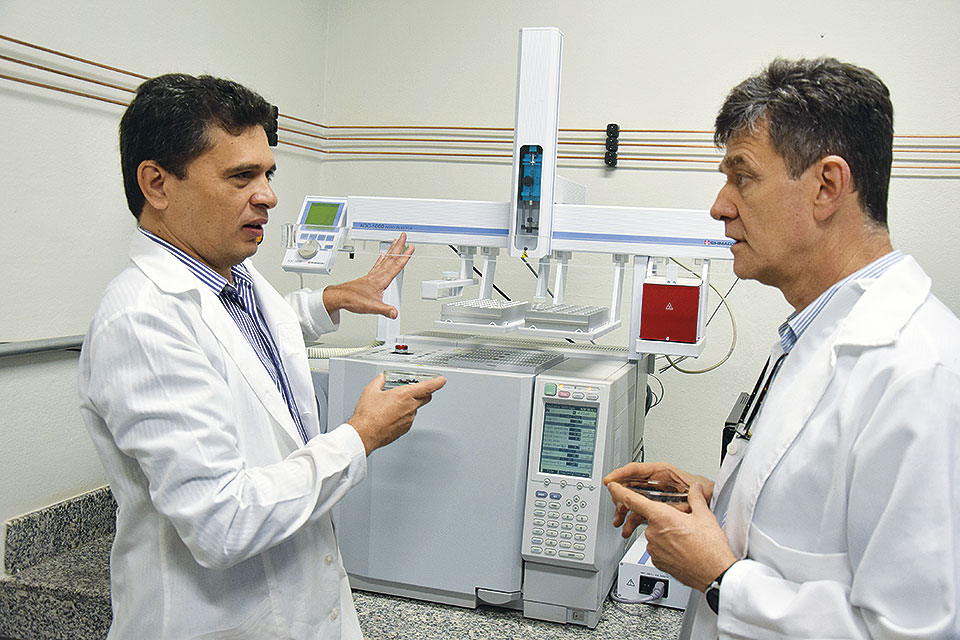Pesquisa indica que cinco frutas típicas da Mata Atlântica possuem propriedades bioativas
As frutas conhecidas como bacupari-mirim, araçá-piranga, cereja-do-rio-grande, grumixama e ubajaí ainda não ganharam fama, nem espaço nos supermercados. Se depender de suas propriedades bioativas, em questão de tempo elas poderão estar não só disputando espaço nas gôndolas como ganhando posição no ranking dos alimentos da moda.
Além dos valores nutricionais, as cinco frutas nativas da Mata Atlântica têm elevadas propriedades antioxidantes e anti-inflamatórias. Foi o que verificou uma pesquisa desenvolvida na Escola Superior de Agricultura Luiz de Queiroz (Esalq) da Universidade de São Paulo (USP) em parceria com a Faculdade de Odontologia de Piracicaba (FOP) da Universidade Estadual de Campinas (Unicamp) e a Universidade de La Frontera, no Chile.
“Não havia muito conhecimento científico sobre as propriedades dessas frutas nativas. Agora, com os resultados do nosso estudo, a ideia é fazer com que elas sejam produzidas por agricultura familiar, ganhem escala e cheguem aos supermercados. Quem sabe elas não se tornam um novo açaí?”, disse Severino Matias Alencar, do Departamento de Agroindústria, Alimentos e Nutrição da Esalq, se referindo ao sucesso comercial da fruta amazônica com grande quantidade de antioxidantes e que hoje tem a polpa exportada pelo Brasil para vários países.
Os professores Severino Matias de Alencar (à esq.), da Esalq, e Pedro Luiz Rosalen, da FOP-Unicamp
No estudo foram avaliados os compostos fenólicos – estruturas químicas que podem ter efeitos preventivos ou curativos – e os mecanismos anti-inflamatórios e antioxidantes do extrato de folhas, sementes e polpa de quatro frutas do gênero Eugenia e uma do gênero Garcinia: araçá-piranga (E. leitonii), cereja-do-rio-grande (E. involucrata), grumixama (E. brasiliensis), ubajaí (E. myrcianthes) e bacupari-mirim (Garcinia brasiliensis), todas típicas da Mata Atlântica.
Como elas são espécies difíceis de serem encontradas e algumas estão em risco de extinção, as plantas foram fornecidas por dois sítios localizados no interior de São Paulo. As duas propriedades comercializam as plantas com o objetivo de preservação da coleção. Um dos produtores possui a maior coleção de frutas nativas do Brasil, somando mais de 1,3 mil espécies plantadas.
“Começamos nosso estudo prospectando as propriedades bioativas das frutas, pois sabíamos que elas poderiam ter boa quantidade de antioxidantes, assim como são as chamadas ‘berries’ americanas, como o mirtilo, a amora e o próprio morango, muito conhecidas pela ciência. Mas nossas frutas nativas se mostraram ainda melhores”, disse Alencar.
De acordo com o estudo, as espécies do gênero Eugenia têm um vasto potencial econômico e farmacológico evidenciado não só pelo número de publicações científicas, mas também pela exploração comercial de suas frutas comestíveis, madeira, óleos essenciais e uso como plantas ornamentais.
Elas são exemplos de alimentos funcionais, que, além das vitaminas e valores nutricionais, têm propriedades bioativas como o combate aos radicais livres – átomos instáveis e altamente reativos no organismo que se ligam a outros átomos, provocando danos como envelhecimento celular ou doenças.
“O organismo tem naturalmente antirradicais livres, que neutralizam e eliminam os radicais livres do corpo, sem causar dano. Porém, fatores como idade, estresse e alimentação podem promover um desequilíbrio nessa neutralização natural. Nesses casos, é preciso contar com elementos exógenos, ingerindo alimentos que tenham agentes antioxidantes como os flavonoides, as antocianinas do araçá-piranga e das outras frutas do gênero Eugenia”, disse Pedro Rosalen, da Faculdade de Odontologia da Unicamp em Piracicaba.
O pesquisador ressalta que há cerca de 400 espécies pertencentes ao gênero Eugenia distribuídas pelo Brasil, incluindo várias espécies endêmicas. “Temos uma imensidão de frutas nativas com compostos bioativos que trariam benefícios para a saúde da população. É preciso estudá-las”, disse.
Campeão contra inflamação
As frutas estudadas no projeto com elevada atividade antioxidante para serem usadas em indústrias de alimentos e farmacêuticas também tiveram pesquisadas as capacidades anti-inflamatórias. A grande estrela foi a araçá-piranga, como demonstraram em artigo publicado no
Journal of Functional Foods.
“A araçá-piranga, espécie ameaçada de extinção, teve a melhor atividade anti-inflamatória em comparação com a de outras frutas do gênero Eugenia”, disse Rosalen. “O mecanismo de ação também é muito interessante, pois ocorre de forma espontânea e logo no começo da inflamação, impedindo uma via específica do processo inflamatório. Ela age também no endotélio dos vasos sanguíneos, evitando que os leucócitos transmigrem para o tecido agredido, reduzindo a exacerbação do processo inflamatório”
Rosalen destaca que os antioxidantes não têm como função única combater o envelhecimento ou a morte celular, mas a prevenção de doenças mediadas por processo inflamatório crônico. “A ação oxidante dos radicais livres também significa o surgimento de doenças inflamatórias dependentes, como diabetes, câncer, artrite, obesidade, doença de Alzheimer”, disse.
“Não percebemos muitas dessas lesões provocadas pelos radicais livres. São as inflamações silenciosas. Por isso, é importante a ação de sustâncias antioxidantes, que podem neutralizar os radicais livres”, disse Rosalen.
As pesquisas colaborativas, apoiadas pela Fapesp e pela Universidad de La Frontera, também permitiram ampliar o conhecimento sobre espécies nativas do Chile. Em um dos estudos, os autores demonstraram a atividade antioxidante e vasodilatadora da murtilla (Ugni molinae), uma fruta nativa do país.
No estudo publicado na
Oxidative Medicine and Cellular Longevity, os pesquisadores destacam que o uso de preparações alimentares obtidas a partir de frutas e folhas da murtilla pode ter efeitos benéficos na prevenção e, possivelmente, no tratamento de sintomas de doenças cardiovasculares.
Alencar destaca que conhecer melhor as propriedades pode se mostrar uma boa alternativa para estimular a produção das frutas nativas.
“Antes do projeto com a Universidad de La Frontera, eu e o professor Pedro Rosalen já estudávamos as frutas nativas, pois acreditamos que elas podem revelar ótimas soluções alimentares para a sociedade”, disse.
Leia mais:







